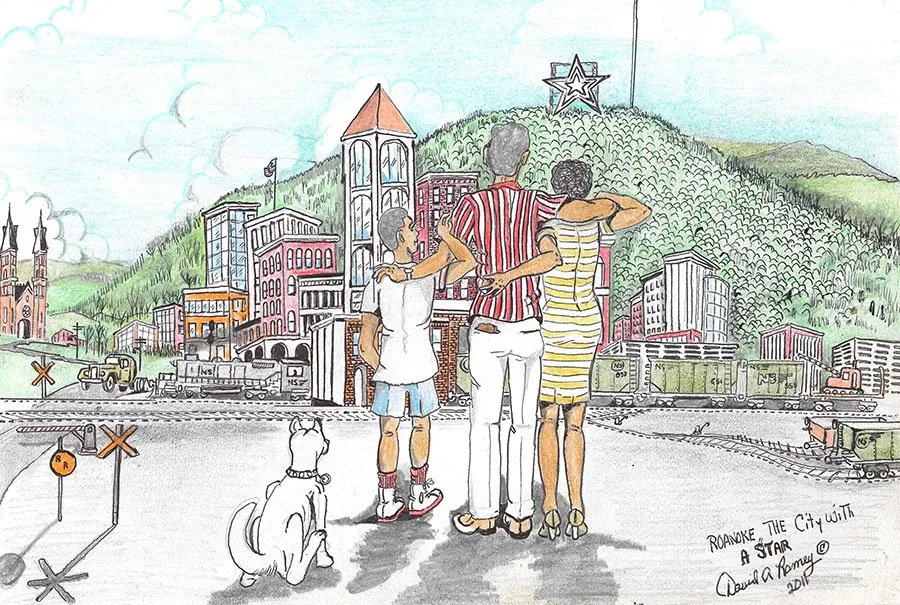
The story below is from our November/December 2023 issue. For more stories like it, Subscribe Today. Thank you!
Historic Gainsboro comes to life through David Ramey, Sr.’s artistic vision, now showcased at The Harrison Museum of African American Culture and the Taubman Museum of Art.
Before urban renewal, Roanoke’s Gainsboro neighborhood was a thriving African American community, bustling with Black-owned businesses, vibrant culture and tight-knit families. Anchored by Henry Street, it boasted theaters, shops and churches that served as social hubs. Gainsboro flourished as a center for African American culture and commerce attracting both residents and visitors from surrounding areas.
Despite the challenges of segregation, Gainsboro thrived, nurturing a rich heritage. However, the tide turned with urban renewal, which razed much of this historic neighborhood, scattering residents and altering its character forever. Over 1,600 homes and Black-owned businesses in Gainsboro were destroyed as a result of urban renewal. The memory of Gainsboro’s vibrant past lives on as a testament to the resilience and spirit of a community that once flourished in the face of adversity. These memories were captured by one artist who grew up in this once prominent neighborhood, David Ramey, Sr. (1939-2017).
Ramey’s artistic journey began in his childhood, where he inherited a love for art from his father. His early sketches revealed a penchant for religious themes, but it was his recollections of Henry Street and Gainsboro that drew the attention of the art community. His ability to vividly recreate scenes from memory, without relying on photographs, is a testament to his exceptional talent. Many of his drawings required anywhere from 40 to 100 hours of scrupulous work, demonstrating his unwavering commitment to preserving his memories and Roanoke history.
The Harrison Museum of African American Culture and the Taubman Museum of Art celebrate the artistic genius of Roanoke’s own David Ramey in a groundbreaking exhibition titled “Gainsboro Road and Beyond.” This collaborative showcase, features approximately 100 drawings and 75 accompanying stories, immersing visitors in Ramey’s nostalgic recollections of Roanoke’s vibrant Black communities of Gainsboro and Northeast from the 1940s to the late 1960s.
Ramey’s art offers a unique perspective, capturing the essence of these neighborhoods before the advent of national urban renewal programs. “It’s a testament to his remarkable talent that this exhibition can serve as a time capsule, preserving memories and stories of the rich culture and brilliance during those decades. The artist’s deep connection to his roots and his unwavering dedication to his craft shine through in every piece on display,” says Charles Price, Board Chairman of the Harrison Museum.
One of the key highlights of the exhibition is the way both the Harrison Museum and the Taubman Museum offer distinct selections of Ramey’s work, encouraging visitors to explore both venues for a comprehensive experience. At the Harrison Museum, patrons can admire drawings and stories from Ramey’s self-published 2012 book, “The Times and Life on Henry Street.” Additionally, a collection of drawings and stories intended for his as-yet-unpublished book, “Gainsboro Road and Beyond,” takes center stage. The Taubman Museum, on the other hand, offers a complete (and possibly earlier) version of this proposed book, along with never-before-seen drawings and yet-to-be-transcribed writings titled “Gainsboro Going into North East.”
Ramey’s artistry is most notably expressed through the more than 700 drawings he created during the 1980s through the early 2000s. These works offer an intimate glimpse into his vision of what once was — a Roanoke steeped in history and culture, unmarred by the effects of urban renewal. Through intricate colored pencil drawings and oil paintings, Ramey encapsulates the spirit of Gainsboro, bringing to life the memories of iconic Black-owned businesses, religious gatherings and the vibrant energy of Henry Street.
Ramey was not just an artist; he was a storyteller, a historian and a custodian of his community’s heritage. His art speaks volumes about the deep connection he shared with the neighborhoods he depicts. Through meticulous attention to detail and a keen sense of color, he transports viewers to a bygone era where life thrived amidst the hustle and bustle of Henry Street. Each drawing is a window into a world that no longer exists, allowing us to rediscover the past through Ramey’s gifted eyes.
The Gainsboro Road and Beyond Exhibition is on display at both museums until March 2024. Admission is free to all patrons.
The story above is from our November/December 2023 issue. For more stories like it, Subscribe Today. Thank you!

